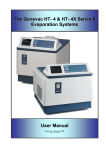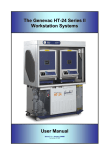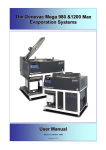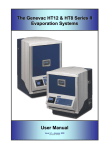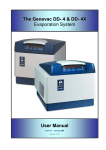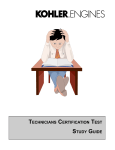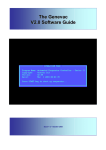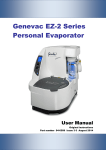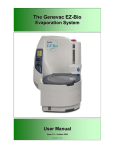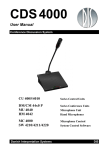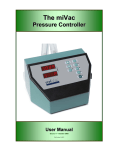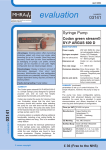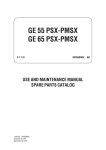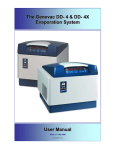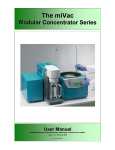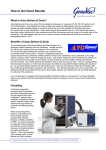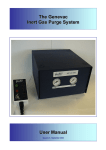Download The Genevac HT-24 Series II Workstation User Manual
Transcript
The Genevac HT-24 Series II Workstation User Manual Issue 1 Revision 10 – September 2005 Part Number 10-1562 Genevac HT-24 Series II Workstation Contents Amendment Control Form............................................................................................................................. 3 1 Introduction ...................................................................................................................................... 4 Details .............................................................................................................................................. 5 List of Solvents................................................................................................................................. 8 2 Safety and Maintenance Notes ........................................................................................................ 9 2.1 Symbols ................................................................................................................................. 9 2.2 Safety..................................................................................................................................... 9 3 System description and options...................................................................................................... 11 3.1 Scope of delivery and installation ......................................................................................... 13 3.2 Checking the delivery ........................................................................................................... 13 3.3 Arranging commissioning ..................................................................................................... 13 3.4 Training ................................................................................................................................ 13 3.5 Positioning the evaporator.................................................................................................... 13 4 Safe loading of rotor – General Document ..................................................................................... 14 Nomenclature................................................................................................................................. 14 Use of Correct Accessories............................................................................................................ 14 Adherence to Mass Limit................................................................................................................ 15 Safe loading of sample holders into swings.................................................................................... 15 Incorrect – Sample Holder rotated.................................................................................................. 15 Correct – Sample Holder well seated ............................................................................................. 15 Incorrect – Sample Holder on edge of swing.................................................................................. 15 Series I vs Series II Swings: ........................................................................................................... 16 Balancing of swings and sample holders........................................................................................ 16 Good procedural practice ............................................................................................................... 17 5 Getting started................................................................................................................................ 18 5.1 Checks prior to power up ..................................................................................................... 18 5.2 How to switch on the evaporator(s) ...................................................................................... 18 5.3 Using the keypad ................................................................................................................. 19 5.4 What the screens do ............................................................................................................ 20 Pre-programmed Runs......................................................................................................... 20 Sample Holder Type ............................................................................................................ 22 Sample Volume.................................................................................................................... 22 Solvent ................................................................................................................................. 23 IR Sensor Control Temperature ........................................................................................... 25 SampleGuard Control Temperature ..................................................................................... 26 SampleGuard Control Channel ............................................................................................ 26 Coolheat Enable Pressure ................................................................................................... 26 Chamber Temperature Control............................................................................................. 26 Rotor Speed......................................................................................................................... 27 Heat-Off Option .................................................................................................................... 27 5.5 Starting a run ....................................................................................................................... 28 5.6 Linked runs .......................................................................................................................... 28 5.7 During a run ......................................................................................................................... 29 IR Sensor ............................................................................................................................. 29 SampleGuard ....................................................................................................................... 30 5.8 How to enter control data ..................................................................................................... 37 10-1562 Issue 1 Revision 10 – September 2005 Page 2 of 47 Genevac HT-24 Series II Workstation Contents (Continued) 6 Trouble Shooting and Maintenance................................................................................................ 42 7 Technical data ................................................................................................................................ 43 8 EC Declaration of Conformity ......................................................................................................... 45 9 Safety............................................................................................................................................. 45 10 Warranty Statement ....................................................................................................................... 45 11 Useful information .......................................................................................................................... 47 Amendment Control Form Revision Number. Issue and Reason for Change Date Issued 1 Changes to Declaration of Conformity. Defrost and Drain note added. January 2004 2 3 4 5 Changes to Declaration of Conformity. Introduction of new Pre-Set runs 51 -100 within the software. Introduction of Warranty Statement Introduction of Entrapment Warning February 2004 01 March 2004 26 April 2004 21 May 2004 6 7 8 9 10 Updated Images Definition of acceptable Out Of Balance Criteria Changes to Declaration of Conformity. Updated Waste Container images and change in Height dimensions. Information on the correct use of SampleGuard Probes 02 June 2004 14 July 2004 21 September 2004 08 December 2004 28 September 2005 These instructions are subject to change without notice. No part of these instructions may be reproduced in any form or be processed, duplicated or distributed by electronic or optical means without the written permission of Genevac Limited. All rights reserved. © Genevac Limited These operating instructions should be read before you use the Genevac HT-24 Evaporating System. Keep them near the system for easy reference. Your attention is drawn in particular to Paragraph 2 Safety and Maintenance Notes. 10-1562 Issue 1 Revision 10 – September 2005 Page 3 of 47 Genevac HT-24 Series II Workstation 1 Introduction Drawing on extensive experience in the drug discovery field, the HT-24 Workstation is designed to provide very high performance coupled with ease of use, occupying the minimum of laboratory space. The HT-24 comprises a Workstation/Trolley complete with 2 condensers, 1 for each evaporator, a Scroll Pump and an 11 litre Solvent Waste Container. The HT-24 can accommodate 2 x HT-8 or 2 x HT-12 Series II evaporators or a combination of both, although it can also be used with a single evaporator installed at either position. Position 1 is the left hand position viewed from the front. The status of each individual evaporator is displayed and controlled on a single keypad, display module indicating the run time, the vacuum, rotor temperature and chamber temperature on digital displays. Simple to use up-down controls enable the run time, rotor and chamber temperatures to be set in an instant and single push buttons set the other functions. Either evaporator can run independently or both evaporators can run together. Processing can be staggered; one unit working, the other being emptied/ filled. Simultaneous extraction of independent solvents is possible, using both evaporators, provided that these do not react within the drain circuit and waste container. The condensers are capable of chilling, defrosting and draining independently, using smart technology integrated with V2-01 software. A load cell monitors the level of fluid in the Waste Solvent Container. When the predetermined weight is reached, the Waste Full lamp on the HT-24 control panel will illuminate and an audible buzzer will sound. The volume of waste solvent in the container varies upon the individual solvents used due to their specific gravity. A static-dissipating device is in contact with the waste container when it is fitted to the HT-24. The single scroll pump is shared between the 2 evaporators by means of a vacuum valve manifold, which intelligently switches the pump to each evaporator. Data Logging is available independently from each evaporator. Dependent on user hardware, both evaporators could be logged to the same PC. A custom fume hood is available as an option, providing a totally enclosed system. This is fitted on top of the HT-24. There are 3 sliding transparent doors in the front for easy access to the evaporators and a window in each side. Fumes are extracted by connecting a suitable duct to the Exhaust Spigot in the roof of the fume hood from your extraction system. A flow meter is located in the top right corner to monitor performance. This manual will guide you through the start up requirements, set up needs and operation of the system to facilitate the most efficient procedure to protect your product’s integrity and to ensure optimum performance at all times. 10-1562 Issue 1 Revision 10 – September 2005 Page 4 of 47 Genevac HT-24 Series II Workstation Details HT-24 Fitted with 2 x HT-12 Complete With “Optional” Fume Hood - Front View Note: 3 Sliding doors in fume hood for easy access Scroll Pump & Catch Pot Door Open 10-1562 Issue 1 Revision 10 – September 2005 Control Panel Waste Solvent Container Door Open Page 5 of 47 Genevac HT-24 Series II Workstation Details (Continued) WASTE FULL LED Illuminates when Waste Solvent Container is full OPEN CHAMBER 2 BUTTON Press to open chamber door on evaporator 2 OPEN CHAMBER 1 BUTTON Press to open chamber door on evaporator 1 OFF BUTTON Press to turn off HT-24 and evaporators ON BUTTON Press to turn on HT-24 and evaporators EMERGENCY STOP Press to use. Used in an emergency to isolate Mains Power to the HT-24 POWER ON LED Illuminates when HT-24 is switched on Control Panel THE EMERGENCY STOP BUTTON IS NOT TO BE USED TO SHUT DOWN THE SYSTEMS ON A ROUTINE BASIS. 10-1562 Issue 1 Revision 10 – September 2005 Page 6 of 47 Genevac HT-24 Series II Workstation Details (Continued) HT-24 Rear View Fume Hood rear panel removed for clarity Data Connections x 2 & Waste Solvent Pump 10-1562 Issue 1 Revision 10 – September 2005 Mains Power Supply Connections x 3 & Electrical Circuit Breakers Page 7 of 47 Genevac HT-24 Series II Workstation List of Solvents Solvent 3 Density (g/cm ) Density Temp. (°C) Autoprogram Available N Acetic Acid 1.05 20 Acetonitrile (ACN) 0.79 20 Y Ammonium Hydroxide (NH3OH) 0.90 20 Y Y Chloroform (TCM) 1.48 20 Dichloroethane (DCE) 1.24 20 Y Dichloromethane (DCM) 1.33 20 Y Dimethylacetamide (DMAc) 0.94 20 Y Dimethylamine (DMA) 0.68 20 N Dimethylformamide (DMF) 0.94 25 Y Dimethylsulfoxide (DMSO) 1.10 20 Y Ethanol (EtOH) 0.79 20 Y Ethyl Acetate (EtAc) 0.90 20 Y Hexane (Hex) 0.65 20 Y Isopropanol 0.79 20 N Methanol (MeOH) 0.79 20 Y N-Methyl-2-pyrrolidone (NMP) 1.02 25 Y Pyridine 0.98 20 N Tetrahydrofuran (THF) 0.89 20 Y Toluene (PhMe) 0.87 20 Y Tri Ethyl Amine (TEA) 0.73 20 Y Trifluoroacetic acid (TFA) Water 1.54 20 Y 1.00 20 Y HCl, Thionyl Chloride or Di Ethyl Ether compatibilities are not available. Genevac and the ATEX Directive: Please note that it remains the responsibility of the user to consider any solvents being evaporated within the context of the ATEX directive. The presence of solvents on the list above indicates only that they will not damage the system. If further information is required, please contact your Sales Representative or visit http://www.genevac.com/ Those solvents with a “Y” in the “Autoprogram Available” column are available from the “Solvent” drop down list when setting up a run. The solvents with an “N” against them will have to be entered using the “Other” option and the rest of the data entered manually. 10-1562 Issue 1 Revision 10 – September 2005 Page 8 of 47 Genevac HT-24 Series II Workstation 2 Safety and Maintenance Notes 2.1 Symbols The following safety symbols are used throughout this manual. The definitions and scope of each symbol is as described below. WARNING THIS SYMBOL INDICATES HAZARDS THAT CAN LEAD TO SERIOUS MATERIAL DAMAGE OR POTENTIAL SERIOUS INJURY. Caution This symbol provides information about hazards that can be harmful to your health or lead to material damage. Note This symbol provides information about technical requirements, which if not followed, can lead to malfunctions, inefficiency and reduced productivity. This symbol indicates that there may be a risk to sample integrity. 2.2 Safety BEFORE OPERATING THE SYSTEM, IT IS IMPORTANT THAT THE FOLLOWING NOTES ARE READ TO ENSURE THAT THE IMPLICATIONS TO THE SAFETY OF PERSONNEL OPERATING THE SYSTEM AND FOR THE PROTECTION OF SAMPLE INTEGRITY ARE UNDERSTOOD. Samples in the evaporator chamber are subjected to accelerations of up to 500G with a maximum load capacity of 1.5 kg for each rotor position. The following precautions should therefore always be observed. 2.3 Safe loading of evaporator Never exceed the maximum load capacity of 1.5 kg for each rotor position. Always balance all tubes within 10g (+/- 5g). When only one system is being used the acceptable max Out Of Balance (OOB) is 85g, but when both systems are being used the acceptable max OOB per system is 65g. Always locate tubes correctly in sample holders. Always locate sample holders correctly in the rotor aperture. Always load two or four swings of the same type and version in opposite and balanced configurations. For partially loaded holders, evenly distribute tubes in sample holders. Always rotate the rotor by hand after loading and check that all sample holders are correctly located before starting a run and before re-starting an interrupted run. Do not load tubes or vials into sample holders other than those types that have been approved by Genevac Ltd. Do not use sample holders that have not been supplied with your system without consulting Genevac Service. 10-1562 Issue 1 Revision 10 – September 2005 Page 9 of 47 Genevac HT-24 Series II Workstation 2.4 Safe Door Operation The evaporator door is opened and closed manually but locked automatically by an electric actuator. Close and hold the door firmly against the door seal and press and hold the Door Close switch. A single audible beep indicates that the door is locked and it is safe to proceed. A proximity switch will prevent the mechanism from locking if the door is not closed. When opening or closing the Chamber doors, please be aware that there is a possibility of the user trapping their hand between the Left Hand Chamber Door and the Fume Hood as detailed in the picture below: Care should also be taken when closing the Fume Hood sliding doors, that the Chamber Doors are closed first so as to reduce the chance of damage being done to both chamber control moulding and fume hood doors, example photo below: 2.5 Limitations of use Your evaporating system is unsuitable for use under the following circumstances: • With strong mineral acids such as HCl and HBr at all concentrations. • For use as a pressure vessel. 10-1562 Issue 1 Revision 10 – September 2005 Page 10 of 47 Genevac HT-24 Series II Workstation 3 System description and options The HT-24 is a simple, large capacity, stand-alone, space-saving machine centred around two HT-12 or HT-8 Series II evaporators mounted on a small footprint trolley. Each evaporator maintains its normal capability, remote control and data logging but gives faster processing by allowing independent operation. It is easy to use, reliable, robust and safe. The HT-24 gives the user the option of simultaneously evaporating 2 different solvents, providing they’re not reactive. Other system features are sample integrity, rapid defrosting, and pullout sample shelves for loading/ unloading evaporators. Pullout sample shelves A single scroll pump is shared between the 2 evaporators by means of a vacuum manifold, which, using smart technology intelligently, switches the pump to each evaporator as required. The pump is a dry vacuum pump, compact in size, driven directly by a single-phase electric motor and air-cooled. Either evaporator can run independently or both evaporators can run together. Processing can be staggered; one unit working, the other being emptied/ filled. Simultaneous extraction of different solvents is possible, using both evaporators, provided that these do not react with each other within the drain circuit and waste container. The condensers are capable of chilling, defrosting and draining independently, using smart technology integrated with V2-01 software. Automatic drain valves and drain pumps ensure that solvent is removed from the condenser pots. This will only occur if the Waste Solvent Container that it is fitted to the system has free space available and that the door is shut. A load cell monitors the level of fluid in the Waste Solvent Container. When the predetermined weight is reached, the Waste Full lamp on the HT-24 control panel will illuminate and will sound an audible alert. The volume of waste solvent in the container varies upon the individual solvents used due to their specific gravity. Emptying the waste solvent container couldn’t be any easier, just open the right hand corner door of the HT-24, Lift the container away from the HT-24 (Extended hoses allow this), press in the drain hose self-sealing quick release clip and remove the drain hose adapter. Remove the vent pipe and disconnect the Anti-Static strap using the quick snap fitting. Remove the cap and empty the container. Refitting is the reverse. Waste Solvent Container - Pump Drain Hose Removal 10-1562 Issue 1 Revision 10 – September 2005 Page 11 of 47 Genevac HT-24 Series II Workstation The evaporators have solid-state case heaters and Coolheat radiant lamps to heat the chamber and samples. The control of chamber, swing and sample temperature, vacuum ramping rate, chamber pressure, rotor speed is handled by an embedded PC. IR (Infra Red) Sensor (Non contact temperature measuring) is fitted as standard. The end user has the facility to auto program run parameters for any (recognised) solvent/mixture entered. These optimised run parameters are highlighted in Cyan on the display screen, when this Auto Program facility has been selected. Recognised Solvent(s) available from drop down menu. Sample Holder type available from drop down menu. Lyophilisation (Freeze Drying) available as a Rotor Speed selection on evaporators equipped for this configuration. Please note: Lyophilisation samples are to be frozen prior to being placed in evaporator. End of Run Prediction (only available with SampleGuard): 1 2 Heat Flow. Sample Detection. The Run Progress screen has a fully featured graphical display, providing annotated plots for temperature and pressure (now a log scale). The control software enables the user to specify and store a library of up to 100 different evaporation profiles in an uncomplicated manner. Run profiles can also be linked to provide multi stage runs. Up to 100 different profile steps can be linked and iterative loops can also be programmed. With a maximum single run time of just below 100 hours, the system is extremely flexible to meet every requirement. Options Available options include: • • • • • • Bump protection (Dri-Pure) on one or both evaporators SampleGuard on one or both evaporators Extra powerful Coolheat lamps on one or both evaporators Low UV lamp lenses on one or both evaporators (not available with high power lamps) Built in fume extraction (hood and pipe system) Manual Condenser flushing Data Logging is available independently from each evaporator. Dependent on user hardware, both evaporators could be logged to the same PC. The easy-to-use package provides the data needed for process and quality control - conveniently and efficiently. Hardware Required: • • • • PC running ‘Windows’ (95, 98, NT, 2000 or XP). Around 5Mbytes of free space on your hard drive. Serial Port on PC or USB to Serial Adapter. Serial Cable to connect the PC to the Evaporator. Contact your sales representative for purchase and installation details. 10-1562 Issue 1 Revision 10 – September 2005 Page 12 of 47 Genevac HT-24 Series II Workstation 3.1 Scope of delivery and installation Your HT-24 system has to be commissioned by Genevac personnel. On delivery, it is advisable to unpack your system at the point of receipt, to ease the movement of the component parts to the point of use. 3.2 Checking the delivery Check the contents of the delivery as soon as possible against the delivery note and notify Genevac Ltd immediately of any missing or damaged parts. (Refer to section 10 for contact details). 3.3 Arranging commissioning If your system is to be delivered separately to commissioning, Genevac Ltd will contact you prior to the delivery, to agree a date to commission your system. 3.4 Training Commissioning will normally include training in the basic operation of the System. Further in house training is recommended to fully exploit the flexibility of the system. Contact your Sales Representative for details. THE HT-24 EVAPORATOR MUST NOT BE OPERATED BY PERSONNEL WHO LACK THE TRAINING OR PROFESSIONAL EXPERIENCE TO COMPREHEND THE HAZARDS THAT CAN ARISE WHEN USING THE SYSTEM. Personnel without such training require thorough instruction. These operating instructions should form the basis of this instruction. 3.5 Positioning the evaporator Refer to the Technical data for dimensions and Plan view drawing, also refer to Pre Installation Document. When in final position ALL four wheels must be lifted clear of the floor using the inbuilt jacks. The back of the system may be placed against a wall, but must have suitable space either side to permit the opening of the doors. 10-1562 Issue 1 Revision 10 – September 2005 Page 13 of 47 Genevac HT-24 Series II Workstation 4 Safe loading of rotor – General Document Genevac are obliged to include the following information in its entirety, irrespective of the system type. As with a centrifuge, a Genevac centrifugal evaporator must be loaded correctly to remove risk of damage. Failure to correctly load a system can lead to loss of samples, system damage and significant downtime. This guide is intended for new users and also as a reminder for more experienced users. The principles outlined apply to all Genevac evaporators. The document deals with various aspects of loading: • • • • • Use of correct swings and sample holders Observation of weight limits Safe loading of sample holders into swings Balancing of swings and sample holders Good procedural practice Nomenclature Firstly, it is important to understand what is meant by some of the terms that will be used in this document. Most Genevac systems feature “swung” rotors. (Some, however, feature “fixed” rotors, with many angled holes for individual tubes. however is primarily concerned with swung rotors). But this document A swung rotor includes a swing or bucket. Below are drawings of typical swings for HT systems. Open (or standard) Side-Bridge TM Fast-Stack (for microtitre plates) Each of these swing types lifts straight out of the rotor. On large Mega systems, however (not shown here) the swings are generally fixed in place and cannot be lifted out. Which swing is ideal depends on which sample holder is required. There is a large range of sample holders which sit in the swings, into which tubes, vials, beakers or flasks are loaded. Use of Correct Accessories Genevac supply a wide range of sample holders to cover a variety of plate, tube, vial or flask formats. Where no holder is available, custom units can be made. In a few cases worldwide, users have developed their own holders and have collaborated with the Genevac R&D department to ensure the holders are suitable and approved for use. Important properties for a sample holder include: • • • • • • Mass within prescribed maximum limit. Closely matched mass within a set of holders. Correct centre of gravity. Good thermal conductivity. Correct hole form and size tolerance to prevent tube or vial breakage under centrifugal force. For correct use of Sample Guard Probes; refer to SampleGuard - Probe Positions document available at: http://www.genevac.com/applications/downloads1.html All Genevac holders are designed with these constraints in mind. Other 3rd party accessories may not be. Generally, apart from microtitre plates, users are advised not to load non-Genevac holders into a system without first checking with Genevac. It is important that the swings and holders used are suitable for the Genevac system in use. For example, there are some sample holders on sale for the Series II system that might appear to fit in a Series I system but which would exceed the weight limitations. (See next section). If in doubt always ask Genevac before running the system. 10-1562 Issue 1 Revision 10 – September 2005 Page 14 of 47 Genevac HT-24 Series II Workstation There are also instances where a sample holder which is perfectly satisfactory (for the tube or vial it is intended for) becomes unsuitable if used with something else, even though it might appear that the alternative tube fits O.K. The Genevac Accessories Brochure indicates for each holder the maximum tube length that the holder is designed to take, and these limits should always be adhered to. (It is available from the website, http://www.genevac.com/brochure/GenevacAccessories.pdf) Similarly some sample holders are intended for use in a Side-Bridge swing only, not in an Open swing, even though they might appear to fit in the latter. The Accessories Brochure has a note “For use in Side-Bridge Swing” by these items, but if in doubt, ask Genevac. Some users wish to run Genevac systems using the “Bohdan Miniblock” system as their sample holder. Please note, some (not all) of this range of items significantly exceed the mass limitations of a Genevac system. If you plan to use Bohdan Miniblocks in a Genevac system, please contact Genevac for a list of the relevant weights. Adherence to Mass Limit There is a maximum mass that can be loaded onto each position of a Genevac swung rotor, this total includes: • • • • The swing The sample holder The tubes or vials The sample solutions Under no circumstances should this be exceeded. If in doubt what your combined mass total is, load up a full swing and weigh it. In most cases, with normal solvent volumes, any sample holder currently on sale from Genevac will fall within the mass limit for a Series II system. Safe loading of sample holders into swings Applicable where both Series I and Series II evaporators are being used within the same laboratory. There are two ways that it is possible to misload a sample holder into a swing. One (shown below) is to rotate the sample holder such that it rests on the edges of the swing. Incorrect – Sample Holder rotated Correct – Sample Holder well seated Another mode of misloading is illustrated below. Incorrect – Sample Holder on edge of swing Correct Both these modes of misloading are possible with an older version of the Open or standard swing but are virtually impossible with the new design of swing, all Series II systems feature the new design of swing. The following illustration shows the difference. 10-1562 Issue 1 Revision 10 – September 2005 Page 15 of 47 Genevac HT-24 Series II Workstation Series I vs Series II Swings: The older Series I design is easy to distinguish because the corners are not welded. The newer (“Series II“) swing has angled sides that make the incorrect loading illustrated above virtually impossible. Care still has to be taken though. It also has rounded and welded corners. Genevac offer a low cost upgrade to any user who has the old type of swing and who wishes to avoid the possibility of this misloading ever occurring Balancing of swings and sample holders. Opposite pairs of swings need to be balanced within specification and that the swings are of the same type and version. Please note that there are several versions of Side Bridge Swings in circulation with a static weight ranging from 375g to 445g. Ensure that swings of the same static weight are positioned diametrically opposite in the rotor; ideally use the same version of swings in all four position of each rotor. Genevac systems have some inbuilt tolerance for imbalance and a system for shutting off if the out-of- balance is unacceptably high but it is advised that the user aims for no more than 10g imbalance between opposite pairs of swings. Where it is necessary to make “dummy” samples to balance real loads, the balancing load should be of a similar solvent composition. For example, do not balance 200g of 50/50 Water/Acetonitrile with 200g of water, because partway through the run, when the acetonitrile has all gone but the water has barely started evaporating, the system would be 100g imbalanced. Note that with a system such as the Fast-StackTM swing, balancing is slightly more complex. Suppose a “FastStackTM Deepwell” swing is used with two 96 well microtitre plates, 2ml per well. (The Fast-StackTM swing is illustrated on the first page of this document). In one swing, the lower microtitre plate is empty, the upper microtitre plate is full, 1.8mls per well. On the other swing, the reverse is true. The two swings now weigh the same, but if placed opposite each other in a system, would not be balanced, because when the swings rotated to their operating attitude, the centre of mass of one is at a different radius to that of the other. This effect becomes very significant when balancing multi level swings in large Mega systems. It is also preferable not to run with only two swings out of four present on any one level of the rotor. If there are only two swings’ worth of samples, you should still load swings and empty sample holders in the other positions. This ensures the rotor is evenly loaded. 10-1562 Issue 1 Revision 10 – September 2005 Page 16 of 47 Genevac HT-24 Series II Workstation Good procedural practice Finally, there are a few general rules for safe operation of a system: • • • • • • Ensure only users familiar with all the issues outlined in this document are permitted to operate the equipment. Only load swings and sample holders approved by Genevac. System should be loaded and started by the same person. Never leave system unevenly loaded and close the door. Someone may start it. Never start, or restart a system without checking it is evenly loaded, all sample holders are correctly seated, all swings are swinging freely. Refer to SampleGuard - Probe Positions document available at: http://www.genevac.com/applications/downloads1.html for correct use of Sample Guard Probes. Misloading may result in damage to samples and the machine, and could void the warranty. 10-1562 Issue 1 Revision 10 – September 2005 Page 17 of 47 Genevac HT-24 Series II Workstation 5 Getting started The following notes describe the basic start up, set up and run instructions for your HT-24 evaporating system. 5.1 Checks prior to power up Ensure that Data cables are connected if required. Ensure that the 3 mains leads are connected to the rear of the system. Ensure mains supplies are switched on at source. Rear Fume Hood panel removed for clarity Ensure that each evaporator ON/OFF switch is set to ON. These can be permanently left ON as the HT-24 controls power distribution. If already pressed, ensure EMERGENCY STOP button has been reset. THE EMERGENCY STOP BUTTON IS NOT TO BE USED TO SHUT DOWN THE SYSTEMS ON A ROUTINE BASIS. 5.2 How to switch on the evaporator(s) Press the Green power ON button, the POWER ON LED will illuminate. Both systems will power up. The screen on both systems will display the Software Control screen. Select the system that you want to use. Press the appropriate OPEN CHAMBER button or use the keypad on the evaporator. Load your samples following the Safe Loading guide (Section 4 of this manual). Close and hold the door firmly against the door seal and press and hold the Door Close switch. Press the START key on the keyboard to access the Select Run screen. The Select Run screen will load up at the last run that was used. A series of runs have been preloaded from RUN 51 to RUN 100 inclusive. Runs 51 to 98 provide a range of Standard Configurations, details on Page 20. Runs 99 and 100 are only for use by engineers for Maintenance/Diagnostics. 10-1562 Issue 1 Revision 10 – September 2005 Page 18 of 47 Genevac HT-24 Series II Workstation 5.3 Using the keypad The Series II keyboard controls and displays have been designed for ease and simplicity in use. The keyboard has the most used function keys on the left hand side. The right side illuminates when the RUN DATA screen is accessed or user input data is required. The START and STOP keys start and stop a selected run. The cursor direction keys move you around the screen in the direction of the arrows. The ENTER key is used to ‘open’ and ’close’ a field on the Run Data screen when inputting or amending data. Note that the START key also acts as an ENTER key when the keyboard is not illuminated. Operating the MENU key displays the USER MENU screen only when the rotor is not spinning and the chamber is vented. MENU Operating the DISPLAY key displays the RUN LOG screen only when a run is in progress or has finished. DISPLAY Operating the SETTINGS key displays the RUN DATA screen only for the selected run. SETTINGS Note that the RUN DATA screen can also be accessed from the menu VIEW/EDIT DETAILS option on the SELECT RUN screen when a run is not in progress. The following notes describe the function of each screen and provide an explanation of the prompts displayed. 10-1562 Issue 1 Revision 10 – September 2005 Page 19 of 47 Genevac HT-24 Series II Workstation 5.4 What the screens do There are three main control screens. The SELECT RUN screen lists the library of evaporation run profiles you can choose. This screen has the capacity to store 100 different run profiles, from which you can select a particular run or set of runs. The screen is accessed after switching on the pump and evaporator and by pressing the START key on the keyboard. • You store and select your runs on these screens. • Use the UP and DOWN cursor keys to move between profiles. By moving across the horizontal menu bar, using left and right cursor keys. • You can START a run. • You can VIEW and EDIT a profile. • You can CLEAR a profile. • You can COPY a profile. • Start to DRAIN. • Start to DEFROST. • Start to FLUSH. (If Option Fitted) • Adjust your OPTIONS. The 100 profiles are shown on this and nine other screens. The other screens can be accessed quickly by moving the cursor down to the last entry on the page and pressing the down cursor key. This will take you to the last entry on the next page. Alternatively, use the up cursor key. If the evaporator is left on the run select screen for 2 minutes or more then the following status message will appear across the bottom of the screen: This informs you of the Status of the condenser for that particular evaporator, useful where multi-users are involved. Any key press will clear this message. 10-1562 Issue 1 Revision 10 – September 2005 Page 20 of 47 Genevac HT-24 Series II Workstation Pre-programmed Runs (SampleGuard option only) Providing that your HT-24 has the SampleGuard option fitted to the chambers, it will have been loaded with a number of pre-programmed evaporation runs. The runs can be found located at runs 51 to 60 of the RUN selection screen. Desired runs can be copied to the top page so as to be readily available, using the “copy to” function. Methods 61 through to 98 are all associated with these pre-programmed methods, and methods 99 and 100 are for use by Genevac service engineers, please do not alter them. The pre-programmed methods have been designed to cover a group of solvents, such as high boiling point solvents. The table below provides a guide to aid correct run selection. Each method has been programmed to be used with a particular group of solvents, therefore, it may be possible to program a more efficient method for just one of those solvents. If you regularly use a single solvent or solvent mixture, then please contact your Genevac representative, or [email protected] for assistance programming a suitable method. These methods have been designed to make use of all the appropriate features of the system to provide the most optimal evaporation conditions. All methods make use of the automatic end of method detection feature, so that no times need be set, the system will stop when all the samples are dry. Each method has a venting procedure linked to the end of the evaporation process, to help remove residual vapours from the chamber. When using these preset programs, they will only function correctly if Sample Guard probe #1 is placed into the aluminium sample holder block or fast stack swing. Run Name Number BP Range Solvent Examples Application 51 Volatiles - not DCM 60-90°C Ethyl Acetate or Methanol Single volatile solvents with no risk of bumping 52 Very Volatile & DCM 40-90°C DCM (Methylene Chloride) Volatile solvent mixtures, and DCM or Chloroform (Methylene chloride), where risk of bumping is high 53 Medium BP Solvents 90-155°C DMF or Toluene Medium bp solvent or mixture of medium bp solvents 54 Med BP & Volatile 40-155°C DMF & DCM (Methylene Chloride) Mixtures of medium and volatile solvents with high risk of bumping 55 Pre-heat Chamber for High BP solvents No solvents should be present 56 High bp 140+ Rapid pre-heat of chamber before a high bp solvent run, swings and samples MUST be removed before this method is used. High bp solvents 57 Very High BP Solvents 58 HPLC Fractions 59 Aqueous only 60 Remove stubborn solvents - 140-190°C DMF, DMAc, DMSO 190°C + - 100°C - NMP, DMI Very high bp solvents Water & Acetonitrile or Methanol HPLC fractions Water Water only Any Drying samples, which have not been fully dried using another method. The condenser MUST be empty before this method is used 10-1562 Issue 1 Revision 10 – September 2005 Page 21 of 47 Genevac HT-24 Series II Workstation Each line on the SELECT RUN screen is generated from the RUN DATA screen. When the chamber is vented and the rotor stationary, this screen is accessed by selecting EDIT at the foot of the SELECT RUN screen and pressing START. When the system is running, the RUN DATA screen can be accessed directly by pressing the SETTINGS key. SETTINGS • Use the UP and DOWN cursor keys to move between fields. • Press ENTER to ‘open’ a field, make the entry and press ENTER again to ‘close’ the field. • During a run, you access this screen by pressing the SETTINGS key. • You can edit any parameter during a run in this way. • You can set Run Data Protection to protect your data (see below). Toggle between Yes, No and Password. Password requires you entering a personal 4 digit code. If you forget your password DataLogger can retrieve the run details including your password. There are no password requirements when using DataLogger, existing password protected runs can be overwritten. Sample Holder Type • When selected you are presented with the SAMPLE HOLDER menu. • Use Cursor keys to move up and down. • Press select. • Select your sample holder type or if not defined, select Other and enter the details. ENTER to Sample Volume • 10-1562 Issue 1 Revision 10 – September 2005 Select and value(s). enter Page 22 of 47 Genevac HT-24 Series II Workstation Solvent When you select this field you are given a list of solvent types that have already been programmed into the evaporator. Use cursor keys move up and down. to Press ENTER key to select (Highlighted in blue). Please note that the solvent(s) that you have selected from the menu appear in the bottom left corner of the screen. Select Done finished. when Once your selection has been made you are now given an option to Auto Program the remaining run parameters. Press Y to accept Auto Program. If you have entered an unrecognised solvent by selecting Other from the solvent menu, you will not be presented with the option to Auto Program. REFER TO THE TABLE ON PAGE 8 FOR THE SOLVENTS THAT HAVE BEEN CLEARED FOR USE IN AN HT-24. HCl, Thionyl Chloride Or Di Ethyl Ether Compatibilities Are Not Available. 10-1562 Issue 1 Revision 10 – September 2005 Page 23 of 47 Genevac HT-24 Series II Workstation With Auto Program Y[es] selected. The screen will now display the Auto Programmed data in Cyan (Light Blue). With IR Sensor Temperature Control only Elapsed Time is available as a Heat-Off Option. So you will need to manually enter the values for Heat-Off Elapsed Time and End of Run Elapsed Time. If you try to save the run without setting these values then you will get a warning on the screen. You can also set the automatic End of Run Defrost and Drain option here. Only available between linked runs and is typically used to remove mixed solvents. After setting the values save the Run and continue. 10-1562 Issue 1 Revision 10 – September 2005 Page 24 of 47 Genevac HT-24 Series II Workstation If you did not select Auto Program or were not given the option, due to inputting an unrecognised solvent, then you will be presented with this screen. If editing an existing run, parameters will remain as previous settings. If creating a new run, parameters will be set to safe default settings. IR Sensor Temperature Control If you have an IR Sensor you must set IR Sensor Control Temperature within the range of -20 to 70°C. If your evaporator is fitted with SampleGuard then this option will not be available but 2 other options SampleGuard Control Temperature and SampleGuard Control Channel will be. 10-1562 Issue 1 Revision 10 – September 2005 Page 25 of 47 Genevac HT-24 Series II Workstation SampleGuard Control Temperature Set within the range of -20 to 70°C. SampleGuard Control Channel Channel 1 in Swing or Sample Holder. Channel 2 in Sample. Coolheat Enable Pressure Set within the range of 5–400 mbar. Chamber Temperature Control There are available: 3 options Wait for Chamber to Heat Range 45°C. from 0°C to Wait for Chamber to Cool Range 45°C. from 0°C to Automatic Control Temperature is automatically set to an optimised figure for the recognised solvent / mixture selected. 10-1562 Issue 1 Revision 10 – September 2005 Page 26 of 47 Genevac HT-24 Series II Workstation Rotor Speed There are available: 3 options Low Rotor speed applies nominally 300 G. High Rotor speed applies nominally 500 G. Lyophilise Rotor speed = 500 rpm. SampleGuard Coolheat are available. and not Heat-Off Option There are available: 3 options Elapsed Time You must set the values for “Heat-Off Elapsed Time” and “End of Run Elapsed Time”. Heat Flow Automatically detects dryness by monitoring the rate at which the solvent is evaporating. Low solvent loading or if the lamps are turned off may cause Heat Flow to fail. ATTENTION: THE 3 “HEAT OFF” OPTIONS ARE ONLY AVAILABLE IF YOUR EVAPORATOR HAS SAMPLEGUARD FITTED. If failure occurs, select one of the other two options. Sample Detection IF YOUR EVAPORATOR HAS “IR SENSOR” THEN ONLY “ELAPSED TIME” IS AVAILABLE. 10-1562 Issue 1 Revision 10 – September 2005 Monitors the temperature difference between the 2 SampleGuard channels. Page 27 of 47 Genevac HT-24 Series II Workstation 5.5 Starting a run Select the run that you require from the list. Select START from the menu and press START button. You will get an advisory message as shown below (This is can be turned off in the OPTIONS menu): After ensuring that you have satisfied the requirements: Press START to continue, or STOP to shutdown. 5.6 Linked runs If you have used the Next Run option and set the End of Run Defrost and Drain option to Yes then the following message will be displayed at the bottom of the screen. Note: plot is paused during this time. 10-1562 Issue 1 Revision 10 – September 2005 Page 28 of 47 Genevac HT-24 Series II Workstation 5.7 During a run The main section of the RUN LOG screen, gives a graphical display of the real time changes in chamber pressure, spin rate, sample and sample holder temperatures. During the initial pump down, as solvent starts to evaporate, you may notice that the pressure indicated on the graph fluctuates, this is quite normal due to the way that the evaporators and the scroll pump interact. When the pump switches between evaporators a slight pressure rise may occur during the 30 second wait period, this is due to the evaporation of the solvent(s). IR Sensor With an evaporator with IR Sensor fitted, the top left hand section displays the current sample temperature, the chamber temperature, the condenser temperature, the chamber pressure, the total time elapsed and the stage time elapsed if linked runs are being undertaken. • The RUN LOG screen displays the real time events. • The top left block gives current values. • The top right block displays any alarms. • The block at the foot of the screen displays the current status of the system and Instructions. • Pressure is plotted on log scale. • Press STOP to terminate a run at any time. When run enters final drying period the display changes to indicate the time left to End of Run or if linked runs End of Stage. Press the DISPLAY key during a run to return to the RUN LOG screen. Operating the STOP key at any time during a run will terminate the run. The chamber will vent and the rotor will start to spin down. You will not be able to open the chamber until the chamber has reached atmospheric pressure and the rotor has stopped spinning. When the chamber has vented and the rotor stopped, you will be given this STATUS prompt. 10-1562 Issue 1 Revision 10 – September 2005 Page 29 of 47 Genevac HT-24 Series II Workstation SampleGuard With an evaporator with SampleGuard fitted, the top left hand section displays the current temperatures of channels 1 and 2, the chamber temperature, the condenser temperature, the chamber pressure, the total time elapsed and the stage time elapsed if linked runs are being undertaken. • The RUN LOG screen displays the real time events. • The top left block gives current values. • The top right block displays any alarms. • The block at the foot of the screen displays the current status of the system and Instructions. • Pressure is plotted on log scale. • Press STOP to terminate a run at any time. When run enters final drying period the display changes to indicate the time left to End of Run or if linked runs End of Stage. Press the DISPLAY key during a run to return to the RUN LOG screen. Operating the STOP key at any time during a run will terminate the run. The chamber will vent and the rotor will start to spin down. You will not be able to open the chamber until the chamber has reached atmospheric pressure and the rotor has stopped spinning. When the chamber has vented and the rotor stopped, you will be given this STATUS prompt. 10-1562 Issue 1 Revision 10 – September 2005 Page 30 of 47 Genevac HT-24 Series II Workstation When the run is finished, after pressing a key, the following screen is displayed. Select the DRAIN or DEFROST OPERATIONS option using the numeric keys. To access from the main menu select DRAIN or DEFROST and press ENTER. • With the DEFROST CYCLE highlighted, press ENTER to start the defrost cycle. • This will automatically initiate defrosting. • Drain the condenser after every run and at the end of the day. • A defrosted and drained condenser will operate more efficiently. • Periodically check the level of solvent in the waste container. The light on the main control panel will illuminate when the container is full. Screens similar to this are also displayed for DRAIN and, if fitted, the FLUSH option. Select option 1. Skip, to select next run. Defrost and Drain must be carried out at least once a week (to prevent pot freezing / clogging). 10-1562 Issue 1 Revision 10 – September 2005 Page 31 of 47 Genevac HT-24 Series II Workstation If you wish to end the work session on the system, go to the Select Run screen and press STOP. This prompt will be displayed on the SELECT RUN screen. Press Y to close the system down or N to select another run. 10-1562 Issue 1 Revision 10 – September 2005 • The SHUT DOWN screen will be displayed when you select the Y response. • You can restart the run by pressing START at any point. • You can abort Shutdown by pressing START at anytime. • If you want to start a different run, press STOP, select N and press ESC to display the SELECT RUN screen. Page 32 of 47 Genevac HT-24 Series II Workstation The USER MENU is displayed by selecting OPTIONS from the MENU in the SELECT RUN screen. LAMP LAYER SELECTION • In LAMP LAYER SELECTION you can enable or disable different lamp layers. • Press ESC to leave this menu Use the cursor keys to select the LAMP LAYER SELECTION and press ENTER. 10-1562 Issue 1 Revision 10 – September 2005 • Use the UP and DOWN cursor keys to select the lamp layer you wish to disable or enable. • Use the ENTER key to toggle between Enabled and Disabled. • Press ESC to exit this screen. Page 33 of 47 Genevac HT-24 Series II Workstation OPERATOR CONTROLS • In OPERATOR CONTROLS you can adjust the screen brightness to suit your viewing angle. • You can turn the audible warning off or on. • Press ESC to leave this menu Use the cursor keys to select the OPERATOR CONTROLS and press ENTER. 10-1562 Issue 1 Revision 10 – September 2005 • Use the UP and DOWN cursor keys to adjust the screen brightness to suit your viewing angle. • Toggle the beep ON or OFF. • Press ESC to exit this screen. Page 34 of 47 Genevac HT-24 Series II Workstation OPTIONS • In OPTIONS you can Enable or Disable the Auto Shutdown function. • You can disable the Pre-run Checklist prompt screen • Press ESC to leave this menu Use the cursor keys to select the OPTIONS and press ENTER. 10-1562 Issue 1 Revision 10 – September 2005 • Use the ENTER key to toggle between Enabled and Disabled. • Press ESC to exit this screen. Page 35 of 47 Genevac HT-24 Series II Workstation THIS OPTION IS TO ONLY BE USED BY QUALIFIED ENGINEERS. MAINTENANCE Only in exceptional circumstances, under guidance from Genevac, will non-qualified personnel be required to use this option. • In MAINTENANCE you can write the machine settings to file. • Press ESC to leave this menu Use the cursor keys to select MAINTENANCE and press ENTER. 10-1562 Issue 1 Revision 10 – September 2005 • Use the ENTER key to write the machine settings to the file “SIMUL.INI”. • Press ESC to exit this screen. Page 36 of 47 Genevac HT-24 Series II Workstation STATUS Not required under normal conditions. This option displays information useful to Genevac personnel in resolving technical issues. • In STATUS you can write the machine settings to file. • Press ESC to leave this menu Use the cursor keys to select STATUS and press ENTER. 5.8 • The current status evaporator is displayed. • Press ESC to exit this screen. of the How to enter control data The following pages describe how to enter run data, acceptable values and options that may or may not be available for your particular setup. All control data is entered from the RUN DATA screen. From start up of the system and the software control screen, press START to display the SELECT RUN screen. Select the VIEW/EDIT DETAILS option and press START to display the RUN DATA screen. Use the UP and DOWN cursor keys to move between fields. Unless otherwise stated, press ENTER to ‘open’ a field, input your requirement and press ENTER again to ‘close’ the field. 10-1562 Issue 1 Revision 10 – September 2005 Page 37 of 47 Genevac HT-24 Series II Workstation Run Data Locked When set to Yes this setting protects the run data from inadvertent corruption, Password prevents others from editing your run requirements. Press the ENTER key to toggle between Yes, No and Password. Note that you will not be able to make amendments or additions if the data is locked. Lock the data after completing the run entry. Next Run Number This control enables you to link and loop runs in any sequence. If you want to link runs, list the number of the run you want to follow the run you are entering. Repeat this process for any subsequent runs you would like to link. You can also loop a run. The limitation of how many runs you can link will be either the maximum run time of 99 hours 59 minutes or 99 different steps. Linked and looped runs can always be interrupted by manually stopping the system. Use the DOWN cursor key to move to the next field. Run Name Enter the title of the run that should be no more than 20 characters long. Use the DOWN cursor key to move to the next field. Sample Holder Type Press ENTER to display the Select Sample Holder drop down menu. Use the UP and DOWN cursor keys to select the option and press ENTER. If OTHER is selected, the description should be no more than 20 characters long. Sample Volume Solvent Press ENTER and input the volume in mls. Press ENTER to display the Solvent Drop down menu. Use the UP and DOWN cursor keys to select the option(s) and press ENTER. Once your selection has been made select Done and press Enter, you are now given a new option to Auto Program the remaining run parameters. If OTHER is selected, the name should be no more than 31 characters long, press ENTER to return to Solvent drop down menu. 10-1562 Issue 1 Revision 10 – September 2005 Page 38 of 47 Genevac HT-24 Series II Workstation Select Done and press ENTER. IR Sensor Control Temperature NOT AVAILABLE WITH SAMPLEGUARD Press ENTER and input the temperature you wish to limit the sample to during evaporation. This can be in the range of -20 to +70° C. Note that if not specified, the default setting is 40° C. SampleGuard Control Temperature NOT AVAILABLE WITH IR SENSOR NOT AVAILABLE FOR LYOPHILISATION Press ENTER and input the temperature you wish to limit the sample to during evaporation. This can be in the range of -20 to +70° C. Note that if not specified, the default setting is 30° C. Note this is not available for Lyophilisation. Sample Guard Control Channel NOT AVAILABLE WITH IR SENSOR NOT AVAILABLE FOR LYOPHILISATION Press ENTER and input the channel on which you want to control temperature. Channel 1 will normally be assigned to the probe in the sample holder and Channel 2 to the probe in the sample. Note that when powered down, this setting defaults to Channel 1 as the control channel. Note this is not available for Lyophilisation. Coolheat Enable Pressure NOT AVAILABLE FOR LYOPHILISATION Press ENTER and input the pressure below which you want the lamps to be turned on. This can be in the range of 5-400 mbar. If nothing is selected, the setting will default to 400 mbar. Note this is not available for Lyophilisation. Chamber Temperature Control Press ENTER and Select the method from the 3 options displayed: Wait for Chamber to Heat Range from 0°C to 45°C. Wait for Chamber to Cool Range from 0°C to 45°C. Automatic Control Temperature is automatically set to an optimised figure for the recognised solvent / mixture selected. Input the minimum temperature you want the chamber to reach before spin-up will commence. 10-1562 Issue 1 Revision 10 – September 2005 Page 39 of 47 Genevac HT-24 Series II Workstation Rotor Speed Press ENTER to display the Select Rotor Speed drop down menu. Use the UP and DOWN cursor keys to select Low or High or Lyophilise (optional at order). Low speed applies nominally 300 G and high speed nominally 500 G. Lyophilise applies nominally 50 G at a very low rotor speed. Selecting the Dri-Pure option described later will over-ride this option and sets it to High. If nothing is selected, the setting will default to LOW speed. Heat-Off Option ONLY ELAPSED TIME IS AVAILABLE WITH IR SENSOR Heat Flow Select either: Elapsed Time, Heat Flow or Sample Detection. For Elapsed Time enter value in hours and/or minutes Only requires 1 SampleGuard probe. This MUST be used to control the sample holder or swing temperature. NOT AVAILABLE WITH IR SENSOR NOTE: Control Channel Probe MUST be placed in the swing or sample holder Either channel 1 or channel 2 may be used, ensure that the channel chosen is selected as the control channel in the run options. Automatically detects dryness by monitoring the rate at which the solvent is evaporating. Low solvent loading or if the lamps are turned off may cause Heat Flow to fail. If failure occurs, select one of the other two options. For very low solvent loading, requiring very little heat, then the following would be used: Sample Detection Requires both SampleGuard probes, Channel 1 to monitor the swing/holder temperature and Channel 2 in the centre well of the sample holder to monitor sample temperature. Monitors the temperature difference between the 2 channels. NOT AVAILABLE WITH IR SENSOR 10-1562 Issue 1 Revision 10 – September 2005 When the temperature difference reaches the preset figure (Not user configured), the run is terminated. Page 40 of 47 Genevac HT-24 Series II Workstation Heat-Off Elapsed Time This can be in a range of 0 (lamps off for the entire run) to 99 hours 59 minutes. End-of-Run Option This option is the elapsed time after which the run will be stopped. End-of-Run Elapsed Time Press ENTER and input the time after which you want the run to stop. This can be in the range of 1 minute to 99 hours 59 minutes. End of Run Defrost and Drain Pressure Control Regime Press ENTER to toggle between Yes and No. Only available between linked runs and is typically used to remove mixed solvents. Press ENTER to display the Select Pressure Control Option drop-down menu. Use the Up-Down cursor keys to select the pressure option required. Full Vacuum Full Vacuum will take the chamber pressure down to the vacuum capability of the pump. Controlled Pressure When the Controlled Pressure option is selected, the Controlled Pressure field will be displayed. Move down to this field using the DOWN cursor key and press ENTER. Input the pressure you want the chamber to be limited to in the range of 0 to 500 mbar. Dri-Pure DRI-PURE reduces the vacuum over a predetermined period to 50 mbar, then goes to the control pressure as set by the user. NOT AVAILABLE FOR LYOPHILISATION This feature is particularly useful in preventing bumping, (the violent boiling of solvents), resulting in solvents being expelled, which is a source of cross contamination of samples. Bumping can also cause products to be deposited on the glass lenses of the Coolheat lamps, which eventually results in breakages. Note that during the DRI-PURE cycle, which is approximately 40 minutes, the Coolheat function will be disabled. Variable Dri-Pure NOT AVAILABLE FOR LYOPHILISATION Variable Dri-Pure allows the user the option to set: 1) The pressure at which the vacuum ramp will start. 2) The pressure at which the vacuum ramp will end. 3) The total duration of the vacuum ramp. 4) Final Controlled Pressure. 10-1562 Issue 1 Revision 10 – September 2005 Page 41 of 47 Genevac HT-24 Series II Workstation 6 Trouble Shooting and Maintenance Information to be included when available 10-1562 Issue 1 Revision 10 – September 2005 Page 42 of 47 Genevac HT-24 Series II Workstation 7 Technical data Mechanical Data Max rotor RPM 1300 + 1.5% Max rotor RPM DriPure 1800 + 1.5% Max G 500 Drive system Direct Drive Operating imbalance 85g maximum when 1 system is being used. 65g maximum per system if both being used. IR lamp number/evaporator 4 (HT-8) 6 (HT-12) Condenser Specification Temperature -45ºC Main pot capacities 6 litre Pump exhaust pot 1 litre Chamber construction 316L stainless steel Condenser drain valve 316L Stainless steel / PTFE Rapid defrost Yes Vacuum System Vacuum display 0-1200 mbar Vacuum control automatic, 0 mbar - atmosphere Vacuum ramp Yes DriPure Optional SampleGuard Optional System ultimate vacuum 0.4 mbar Auto vacuum vent valve Yes Electrical UK and Europe 3 x 230Vac (+ 10%) 50 Hz, 1-phase. Each supply not greater 13A (3 x Schuko for Europe, including Switzerland, Denmark & China) USA 3 x 208V ac (±10%), 60Hz, 1-phase. supply not greater 15A Max power requirement (peak) Approx. 6.5 kW with high power lamps. (30Amps estimated) 10-1562 Issue 1 Revision 10 – September 2005 Each Page 43 of 47 Genevac HT-24 Series II Workstation Technical data (Continued) Fume Hood Extraction In-flow velocity (min) 0.5 m/s Extraction pressure 25 – 50 Pa Dimensions Width 1346 mm 1420 mm with fume hood 1467 mm side doors open Depth 712 mm 817 mm with fume hood Height 1685 mm 1915 mm with fume hood Weight 700 kg approx Operating Environment Typical location HT synthesis or lab. environment, clean & quiet in proximity of sensitive equipment. Atmospheric pressure 900-1200 mbar at sea level; 750-1000 mbar at altitudes of 1600m. Temperature 15°C to 30°C Humidity 35% - 70% rH Emissions Noise 10-1562 Issue 1 Revision 10 – September 2005 Not exceeding 66dBA at one metre from the evaporator (Measured during DEFROST and DRAIN cycle). Page 44 of 47 Genevac HT-24 Series II Workstation 8 EC Declaration of Conformity We Genevac Limited Declare that this product: HT-24 Series II Workstation Conforms with the relevant Essential Health and Safety Requirements of the European Machinery Directive (89/392/EEC as amended by 91/368 EEC and 93/44/EEC). The EMC Directive 89/336/EEC and the Low voltage Directive 73/23/EEC. *See note opposite. * Note: Under the Low Voltage Directive, 73/23/EEC, the limit for earth leakage current for Class1 portable equipment is specified at 3.5mA. Whilst every effort has been taken to minimise the leakage current of the HT-24, it may slightly exceed this value at, typically, 4.6mA. This is normal and does not indicate a problem with the system. 9 Safety Conformity is demonstrated by compliance with the following specifications:BS EN ISO 12100 pts 1 & 2:2003, Safety of Machinery - Basic concepts, general principles for design. WARNING! EN 60204-1: 1998, Safety of machinery– Electrical equipment of machines-Pt 1 General Requirements THIS EVAPORATOR IS A SAFETY CLASS 1 PRODUCT ACCORDING TO IEC CLASSIFICATION. IT MUST NEVER BE USED WITH ANY INTERRUPTION TO THE SAFETY EARTH CONDUCTOR. IT IS AN INSTALLATION CATEGORY II PRODUCT AND IS INTENDED TO OPERATE FROM A NORMAL SINGLE-PHASE SUPPLY. EN 294: 1992, Safety of machinery – Safety distances to prevent danger zones being reached by the upper limbs. EN1088: 1996, Safety of machinery. Interlocking devices associated with guards. Principles of design and selection. BS EN 61326: 1998, A1, A2 Electrical Equipment for measurement, Control and Laboratory use – EMC Requirements. BS EN 61000-3-2: 2001, Electromagnetic compatibility (EMC). Limits. Limits for harmonic current emissions (equipment input current up to and including 16 A per phase). THIS SYSTEM MUST BE EARTHED THIS EVAPORATOR HAS BEEN DESIGNED TO BE USED IN A POLLUTION DEGREE 1 ENVIRONMENT (NO POLLUTION, OR ONLY DRY NON-CONDUCTIVE POLLUTION). ANY MAINTENANCE OR REPAIR OF THIS PRODUCT SHALL BE CARRIED OUT BY GENEVAC PERSONNEL (OR APPROVED REPRESENTATIVES OF GENEVAC) USING ONLY APPROVED SPARE PARTS BS EN 61000-3-3: 1995, A1, A2 Electromagnetic compatibility (EMC). Limits. Limitation of voltage fluctuations and flicker in low-voltage supply systems for equipment with rated current <= 16 A. BS EN 61010-1: 1993, Safety requirements for electrical equipment for measurement, control and laboratory use. BS EN 61010-2-020, 1995, Safety requirements for electrical equipment for measurement, control and laboratory use. Particular requirements for laboratory centrifuges. 10-1562 Issue 1 Revision 10 – September 2005 Page 45 of 47 Genevac HT-24 Series II Workstation 10 Warranty Statement This product is guaranteed for period of 12 months from the date of delivery to site. In the unlikely event of any defect arising due to faulty materials or construction resulting in system failure, the unit will be repaired free of charge. This to include all labour and component costs incurred. This warranty is subject to the following provisions: 1. System must be sited, installed and operated in accordance with operator instruction manual. 2. Unit only used for purpose it was sold, and in accordance with Genevac published compatible solvent list. 3. Regular cleaning and preventative maintenance schedule to be adhered to as detailed in operator’s manual. 4. Warranty does not cover accidental damage, misuse, modifications or inappropriate repair by untrained personnel. 5. Warranty does not cover consumable items* Failure to adhere to the above would result in the costs of repairs being charged. * Consumable Items: Sample Guard thermocouple probes Cole Vacuum Pump oil Control fuses 10-1562 Issue 1 Revision 10 – September 2005 Page 46 of 47 Genevac HT-24 Series II Workstation 11 Useful information Genevac Limited The Sovereign Centre Farthing Road Ipswich IP1 5AP United Kingdom Sales and Service Hotlines Service Hotline: +44 (0) 1473 243000 If you need to contact Genevac for assistance, use either the telephone or fax Hotlines given. It will always help Genevac Service if you have the serial numbers at hand for the components of your system If you need to contact Genevac Sales for information on Service Contracts or products, use the telephone or fax Hotlines given. Alternatively, Email or visit our web site. Sales Hotline: +44 (0) 1473 240000 Fax: +44 (0) 1473 461176 Email: mailto:[email protected] Web site: http://www.genevac.com Genevac Inc 707 Executive Boulevard Suite D Valley Cottage New York 10989 United States of America Sales and Service Hotline (1) 845 267 2211 Fax (1) 845 267 2212 Email: [email protected] 10-1562 Issue 1 Revision 10 – September 2005 Page 47 of 47
















































